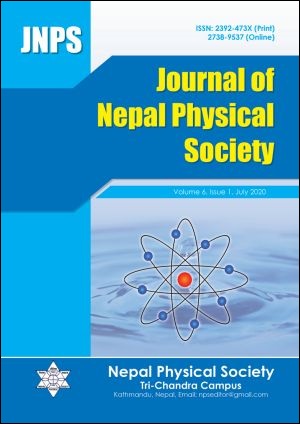Variation of GPS- Tec Measurements of the Year 2014: A Comparative Study with IRI - 2016 Model
DOI:
https://doi.org/10.3126/jnphyssoc.v6i1.30555Keywords:
GPS, GPS-TEC, IRI-TEC, VTECAbstract
Total Electron Content (TEC) measured from Global Positioning System (GPS) receivers at latitude of 29.17°N and longitude of 80.62°E in Bardiya and TEC derived from IRI- 2016 model is compared for the year 2014, which is geo- magnetically active year. To find out the reliability of IRI-2016 model, comparative study of GPS- TEC and IRI- TEC is very helpful for the study of TEC variations. In this work diurnal, day to day, month to month and seasonal variations of GPS- TEC and IRI- TEC are analyzed. The comparative study shows that the highest value of VTEC (53 TECU) is found on the day of 61 and over estimation of IRI-TEC over GPS TEC were found from day 151 to day 258. Similarly, months of March and December are the highest and lowest values of VTEC obtained respectively. For monthly variation, IRI-TEC is followed by the pattern of variation with GPS- TEC, where peak value is found to be around 0800 UT to 1100 UT (0145 LT to 0445 LT). The higher values of both GPS- TEC and IRI TEC have been found in spring season, while the lower values are in winter season in case of IRI TEC and partially in summer (before 1000 UT) and winter (after 10UT) in case of GPS TEC. The maximum difference between the value of IRI modeled TEC and GPS TEC has been found to be around 15 TECU, whereas the minimum value is almost around 1 TECU. The correlation between IRI- 2016 modeled TEC and GPS- TEC has been found to be positive (0.57) showing good matching on variations of GPS TEC and IRI-model results.
Downloads
Downloads
Published
How to Cite
Issue
Section
License
All right reserved. No part of this Journal may be reproduced in any form or by any electronic or mechanical means, including information storage and retrieval system, without permission in writing from the publisher, except by a reviewer who may quote brief passage in a review. The views and interpretation in this journal are those of author(s) and they are not attributable to the NPS.




